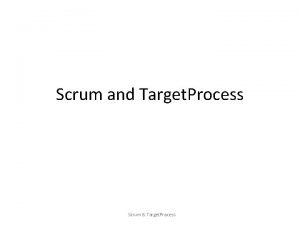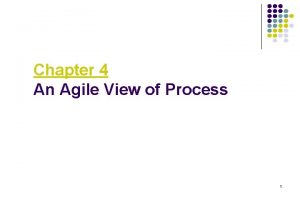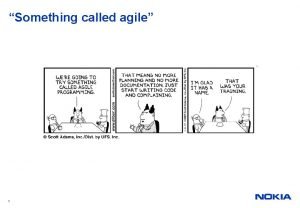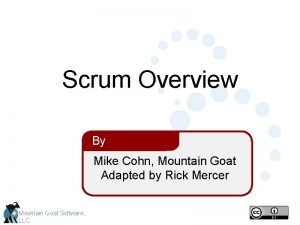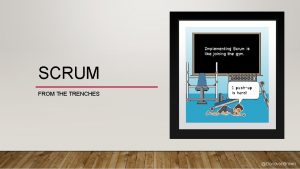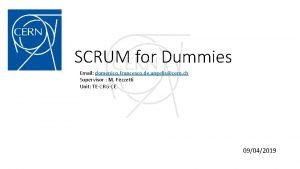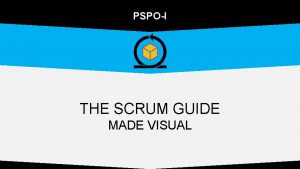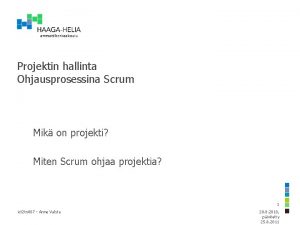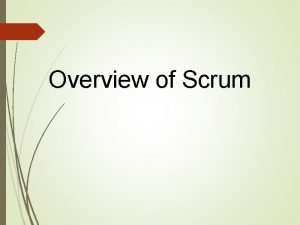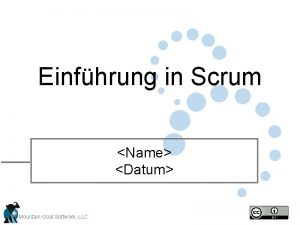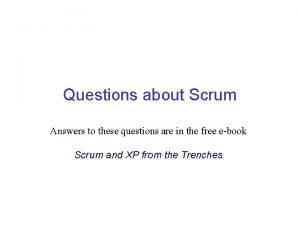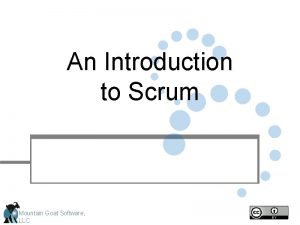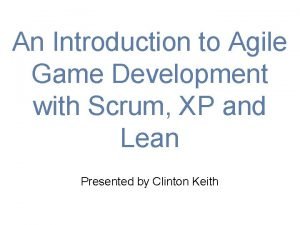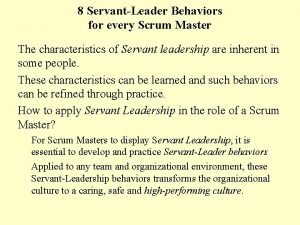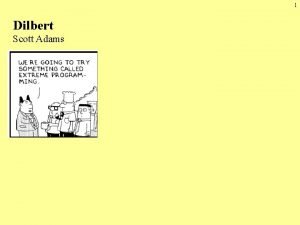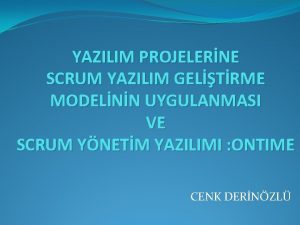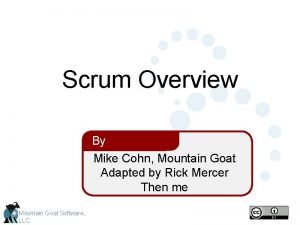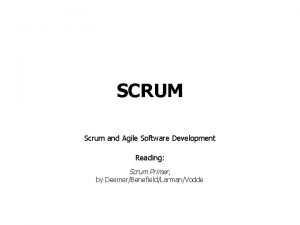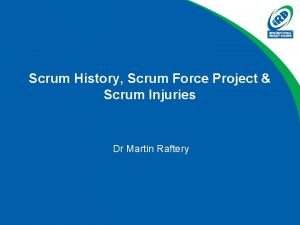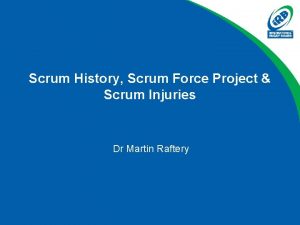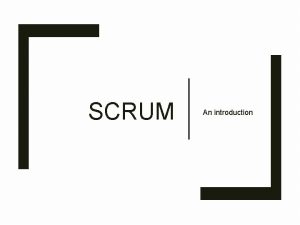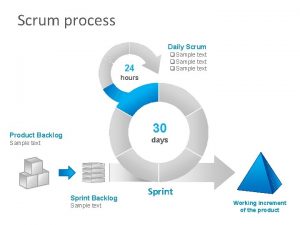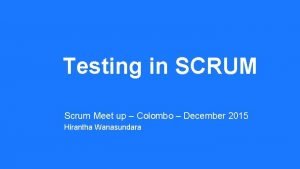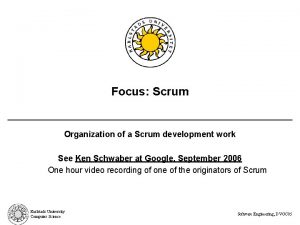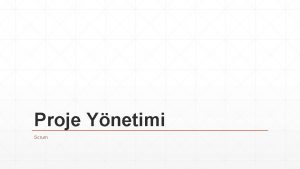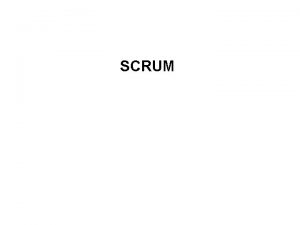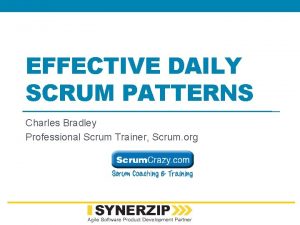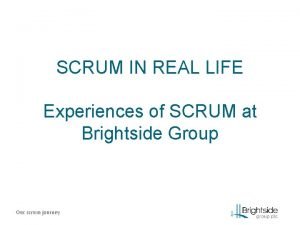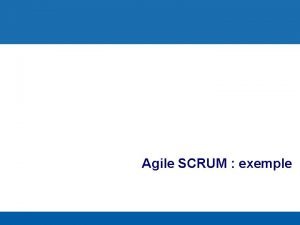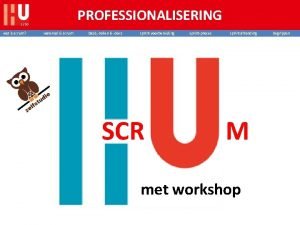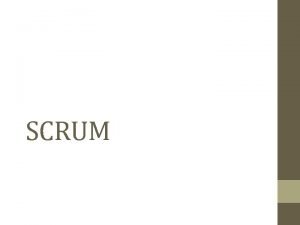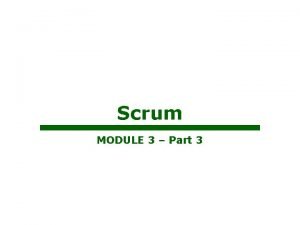Scrum and Target Process Scrum Target Process Target























- Slides: 23

Scrum and Target. Process Scrum & Target. Process

Target. Process • Target. Process is a visual management tool used to manage and monitor processes • Allows for easy visualization of work by all team members • Allows management a tool for watching progress and measuring success

Scrum • A way for teams to work together to develop a product • Occurs in small pieces with each piece building upon previously created pieces. • Encourages creativity • Team takes ownership of the product • Enables feedback and change – Recommended video • http: //scrumtrainingseries. com/Intro_to_Scrum/Intro_to_Sc rum. htm

Scrum Roles • Product Owners – Determines what needs to be built in the next 30 days or less – Serves as the liaison with the stakeholders to report progress • Scrum Team – Delivers a release every 30 days that works – Consists of developers and quality assurance – Responsible for demonstrating what they built • Scrum Master – Facilitates the process

Creating the Project • Step one – Create your project • We will use a basic version of the File Manager Rewrite project as our example

Adding Users • Add users to project

Creating Backlog • Different approaches – Larger project with multiple teams • Epics/Features followed by User Stories – Smaller project with single team • User Stories We will start with User Stories for this sample

User Stories • What is a user story? – File manager project has one basic set of users so it will be simple (in scrum, simple is better) • View Course Section Common and Content directories and their contents • Create lessons, subtopics and pages • Move lessons, subtopics and pages • Delete lessons, subtopics and pages – Each user story needs to define “done”

Create the Backlog • The Backlog Board – Usually set up by the Project Owner – Simple to create a new – Switch View structure eases the entry process – Using shift click, user can drag drop priorities – Set the business value – default Nice to Have

Map the Stories • When Story Mapping is useful – When you discover that many of the users stories should be grouped into one feature or release • Possible Example – Basic File Manager needs to be built before the rest of the project can be delivered. That may be the first release feature.

Release Planning • Easy to create a release plan • Let’s do it together but normally this would be done by the Project Owner and then reviewed LET’S by the Scrum Team in the Release Planning DO IT! Meeting

Release Planning Meeting • Estimation Game – Different ways of estimating • Target. Process uses Fibonacci sequence (1, 2, 3, 5, 8, 13, 21, 34, etc. ) http: //en. wikipedia. org/wiki/Fibonacci_number – Based on effort and is relative – Only for current release • Recommended Video – http: //scrumtrainingseries. com/Backlog. Refinement. M eeting/Backlog. Refinement. Meeting. htm

Estimation Game • Estimation based on Effort + Complexity + Doubts & Risks • Each Scrum Team member displays a number that reflects how they view the effort of the user story. Some may think that the user story may be more complex than others. • High number and low number hold a discussion and revote happens until a consensus is determined by the group. • Remember to keep things “relative”

Iteration or Sprint • PO builds the Iteration or Sprints • Usually 30 days in length • User stories are moved in during a Sprint Planning meeting with the Scrum Team – This helps the team to understand the business value and take ownership of the process

Sprint Planning Meeting • Calculate Velocity for each iteration – Total story points/number of iterations helps set the goal – Considerations of team availability • Move user stories into the iteration keeping an eye on the story points and velocity • Building tasks

Building Tasks • As a team, tasks are built for each story in the current sprint – User Story = View directories/files, etc • • Design interface Program backend Program interface Testing – yes a separate task for each story! • Team members work together to decide who will work with what task and adds the estimated time

Sprint in Progress • Daily Scrum Meeting – Rules are simple! 15 minutes in length Same time each day All scrum team members attend PO does not attend but should be available to answer questions • Only Three Questions! • • – What did you accomplish yesterday? – What do you plan to accomplish today? – Any impediments?

Daily Reporting • At the end of the day, all scrum team members should report to the scrum master the task(s) that worked on with the time spent that day. – Can be emailed to the Scrum Master or entered into the Target. Process directly – Very valuable to the scrum process!

Measuring Progress Burn Down Chart

What we don’t want!

Scrum Meetings Overview

Benefits to Scrum • Happy Customers – See much faster results in increments – Help define the process • Reduced Product Costs – Increased production speed – Skipping work that is not essential to releasing a viable product • Happy, Productive Team – Building a product that gets released – Takes ownership in the process

Benefits to Target. Process • Ease of usage to build and track • Customization available based on roles • APIs are available to help integrate other tools if desired
 Target process scrum
Target process scrum Scrum process
Scrum process Primary target market and secondary target market
Primary target market and secondary target market Scrum master is both a bulldozer and a shield
Scrum master is both a bulldozer and a shield Scrum mountain goat
Scrum mountain goat Scrum from the trenches
Scrum from the trenches 3 artifacts of scrum
3 artifacts of scrum Scrum-0033
Scrum-0033 Team foundation server scrum
Team foundation server scrum Pspoi
Pspoi User story esimerkki
User story esimerkki Scrum agenda
Scrum agenda Mountgoat gutschein
Mountgoat gutschein Scrum points
Scrum points Impediments in scrum
Impediments in scrum Introduction to scrum
Introduction to scrum Mountain goat scrum
Mountain goat scrum Eligasi
Eligasi Scrum crm
Scrum crm A day in the life of a scrum master
A day in the life of a scrum master What is one example of a servant leader behavior pattern?
What is one example of a servant leader behavior pattern? Dilbert agile scrum
Dilbert agile scrum Scrum modeli
Scrum modeli Mountain goat scrum
Mountain goat scrum
